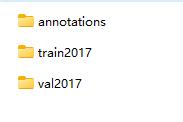YOLOx 自定义数据集训练方法2(COCO)
自定义数据集同样采用Labelme进行标注。
安装方法,请参考《Labelme安装与运行》
标注方法,请参考《YOLOv5 自定义数据集训练方法》
标注完之后,Labelme会生成一堆json的文件。
按照前面的例子,COCO的训练文件格式如下:

我们需要将Labelme的标注文件json,转换成上面这种格式,转换代码如下:
import os
import json
import numpy as np
import glob
import shutil
from sklearn.model_selection import train_test_split
np.random.seed(41)
#0为背景
classname_to_id = {"CeMian": 1, "Zhong": 2}
class Lableme2CoCo:
def __init__(self):
self.images = []
self.annotations = []
self.categories = []
self.img_id = 0
self.ann_id = 0
def save_coco_json(self, instance, save_path):
json.dump(instance, open(save_path, 'w', encoding='utf-8'), ensure_ascii=False, indent=1) # indent=2 更加美观显示
# 由json文件构建COCO
def to_coco(self, json_path_list):
self._init_categories()
for json_path in json_path_list:
obj = self.read_jsonfile(json_path)
self.images.append(self._image(obj, json_path))
shapes = obj['shapes']
for shape in shapes:
annotation = self._annotation(shape)
self.annotations.append(annotation)
self.ann_id += 1
self.img_id += 1
instance = {}
instance['info'] = 'spytensor created'
instance['license'] = ['license']
instance['images'] = self.images
instance['annotations'] = self.annotations
instance['categories'] = self.categories
return instance
# 构建类别
def _init_categories(self):
for k, v in classname_to_id.items():
category = {}
category['id'] = v
category['name'] = k
self.categories.append(category)
# 构建COCO的image字段
def _image(self, obj, path):
image = {}
from labelme import utils
img_x = utils.img_b64_to_arr(obj['imageData'])
h, w = img_x.shape[:-1]
image['height'] = h
image['width'] = w
image['id'] = self.img_id
image['file_name'] = os.path.basename(path).replace(".json", ".jpg")
return image
# 构建COCO的annotation字段
def _annotation(self, shape):
label = shape['label']
points = shape['points']
annotation = {}
annotation['id'] = self.ann_id
annotation['image_id'] = self.img_id
annotation['category_id'] = int(classname_to_id[label])
annotation['segmentation'] = [np.asarray(points).flatten().tolist()]
annotation['bbox'] = self._get_box(points)
annotation['iscrowd'] = 0
annotation['area'] = 1.0
return annotation
# 读取json文件,返回一个json对象
def read_jsonfile(self, path):
with open(path, "r", encoding='utf-8') as f:
return json.load(f)
# COCO的格式: [x1,y1,w,h] 对应COCO的bbox格式
def _get_box(self, points):
min_x = min_y = np.inf
max_x = max_y = 0
for x, y in points:
min_x = min(min_x, x)
min_y = min(min_y, y)
max_x = max(max_x, x)
max_y = max(max_y, y)
return [min_x, min_y, max_x - min_x, max_y - min_y]
if __name__ == '__main__':
labelme_path = "labelme/"
saved_coco_path = "out/"
# 创建文件
if not os.path.exists("%scoco/annotations/"%saved_coco_path):
os.makedirs("%scoco/annotations/"%saved_coco_path)
if not os.path.exists("%scoco/train2017/"%saved_coco_path):
os.makedirs("%scoco/train2017"%saved_coco_path)
if not os.path.exists("%scoco/val2017/"%saved_coco_path):
os.makedirs("%scoco/val2017"%saved_coco_path)
# 获取images目录下所有的joson文件列表
json_list_path = glob.glob(labelme_path + "/*.json")
# 数据划分,这里没有区分val2017和tran2017目录,所有图片都放在images目录下
train_path, val_path = train_test_split(json_list_path, test_size=0.12)
print("train_n:", len(train_path), 'val_n:', len(val_path))
# 把训练集转化为COCO的json格式
l2c_train = Lableme2CoCo()
train_instance = l2c_train.to_coco(train_path)
l2c_train.save_coco_json(train_instance, '%scoco/annotations/instances_train2017.json'%saved_coco_path)
for file in train_path:
shutil.copy(file.replace("json","jpg"),"%scoco/train2017/"%saved_coco_path)
for file in val_path:
shutil.copy(file.replace("json","jpg"),"%scoco/val2017/"%saved_coco_path)
# 把验证集转化为COCO的json格式
l2c_val = Lableme2CoCo()
val_instance = l2c_val.to_coco(val_path)
l2c_val.save_coco_json(val_instance, '%scoco/annotations/instances_val2017.json'%saved_coco_path)
相关配置如下:
当前标注名称:classname_to_id = {"CeMian": 1, "Zhong": 2}
图片和json文件路径:labelme_path = "labelme/"
输出路径:saved_coco_path = "./"




